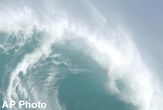Tsunamis: The Grave, Global and Unpredictable Threat

In an eerie repeat of an event two months ago, thousands of resident in Japan fled to higher ground this weekend after a faraway magnitude 8.2 earthquake triggered a tsunami warning.
Only small and relatively harmless waves developed this time, as in November.
The warnings came in part because of heightened efforts by tsunami experts worldwide following the devastating 2004 Indonesian event that killed more than 200,000 people. Japan has since set up its own tsunami warning system.
But disaster experts know that false warnings can breed complacency. So why does one earthquake generate huge waves while another does not?
The paddle effect
Earthquakes that occur under the seafloor can generate tsunamis when chunks of the planet's crust separate. One slab lifting rapidly acts as a giant paddle.
The resulting waves are hard to predict for several reasons. Nobody knows how a quake has affected the seafloor until hours, days or even months after the event. And a tsunami is almost imperceptible on the open ocean, rising to full ferocity only as it nears the shore [graphic]. Plus, buoys that measure the tsunamis are sparse, often thousands of miles apart.
Sign up for the Live Science daily newsletter now
Get the world’s most fascinating discoveries delivered straight to your inbox.
Not all quakes are the same, and sometimes the paddle effect is minimal or nonexistent if the slabs move laterally instead of up and down [graphic], or if the origin of the quake is too deep beneath the seafloor.
"Shallower events will have a huge effect," explains Jian Lin of the Woods Hole Oceanographic Institution.
The 2004 Sumatran quake was colossal, eventually put at magnitude 9.3. But an 8.7-magnitude earthquake in 2005 originated at the same location. It was certainly large enough to generate a devastating tsunami, scientists say, but it did not. The exact reasons remain mysterious.
Global threat
Meanwhile, tsunami threat awareness is growing, based on discoveries of historical tsunamis generated by earthquakes and also volcanoes and landslides. Ironically, the threat of mega-tsunamis was outlined in detail at a meeting of thousands of geologists in San Francisco just two weeks prior to the 2004 Indonesian catastrophe.
One recent study found that a volcano avalanche 8,000 years ago triggered a tsunami taller than a 10-story building that scoured the entire Mediterranean seashore. In November, scientists in Europe met to discuss the lack of a tsunami warning system in the Mediterranean.
And several studies have warned that major tsunamis are likely, and in fact eventually inevitable, along the U.S. West Coast, East Coast and even in the Gulf of Mexico. Even with better warning systems and effective evacuations, a major U.S. tsunami could have a wave of financial implications. A tsunami in Southern California could kill up to a million people (many who would simply not have time to evacuate given a perfect warning system) and cause $60 billion in damages, according to one study. Part of the dollar cost would involve the region's major ports being shut down for months.
- Natural Disasters: Top 10 US Threats
- Mystery of Deadly 1946 Tsunami Deepens
- All About Tsunamis
Robert is an independent health and science journalist and writer based in Phoenix, Arizona. He is a former editor-in-chief of Live Science with over 20 years of experience as a reporter and editor. He has worked on websites such as Space.com and Tom's Guide, and is a contributor on Medium, covering how we age and how to optimize the mind and body through time. He has a journalism degree from Humboldt State University in California.










